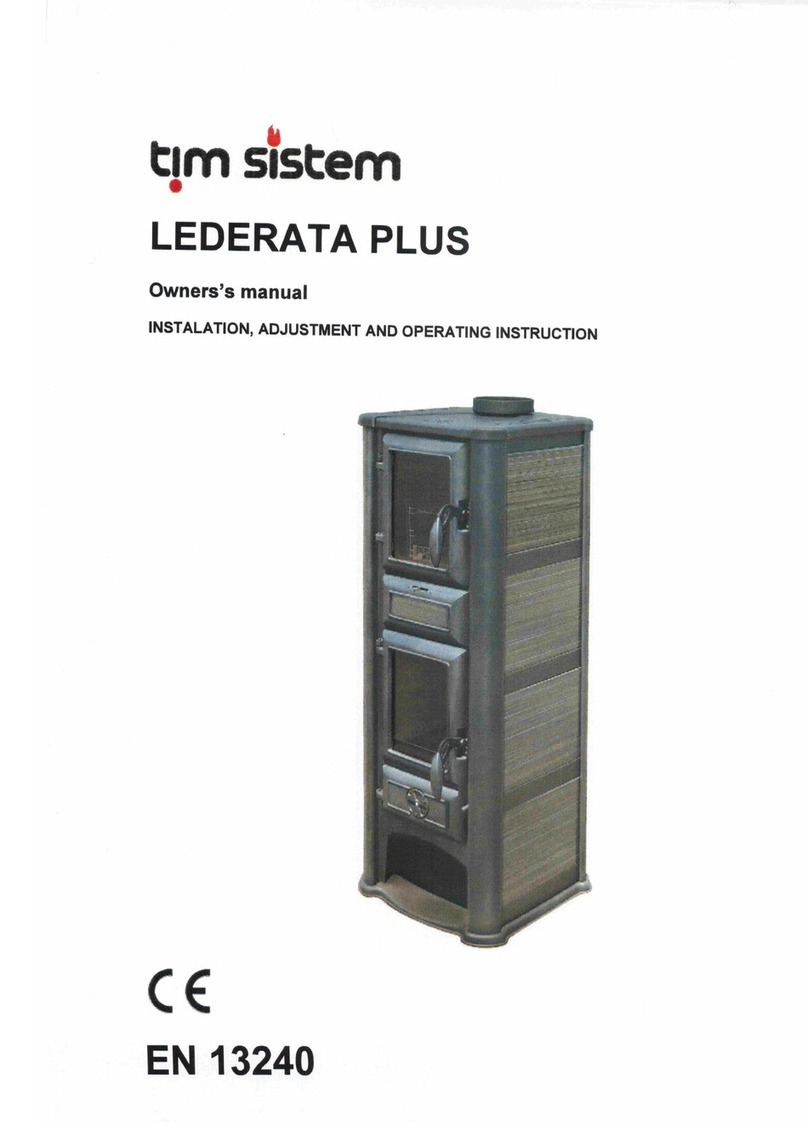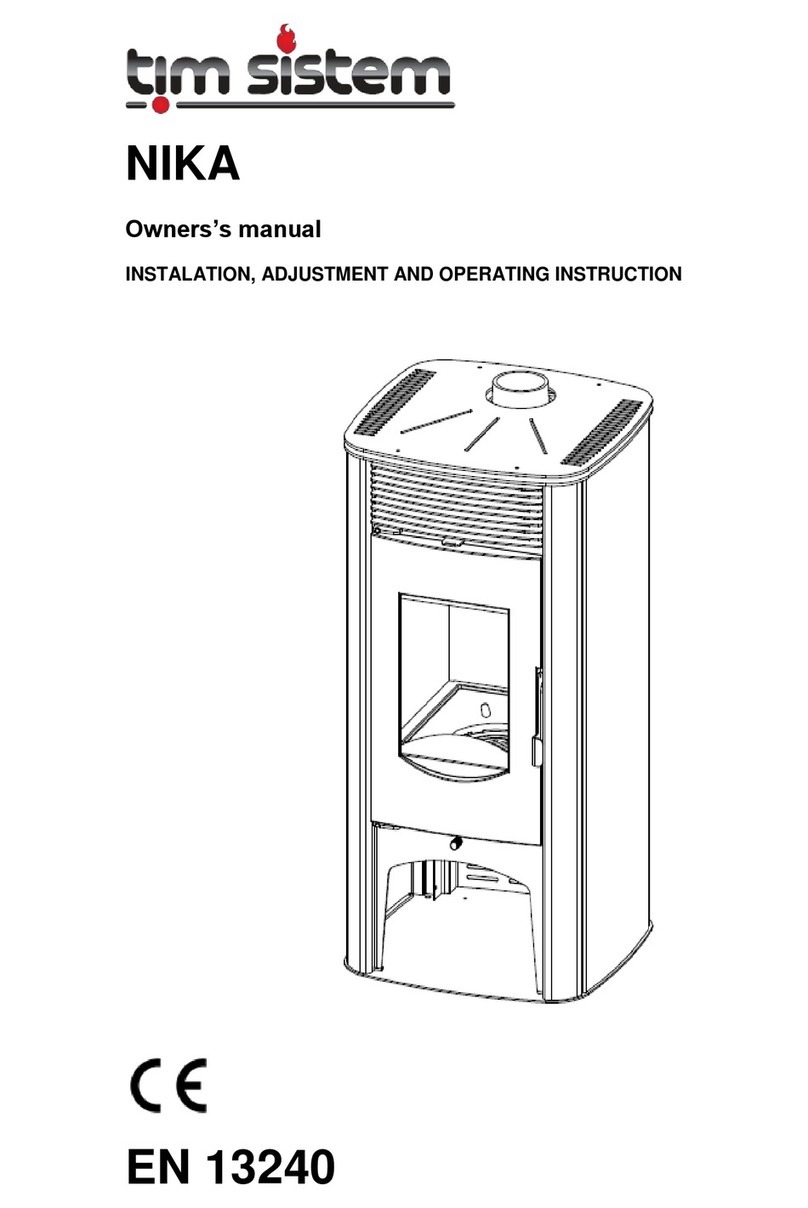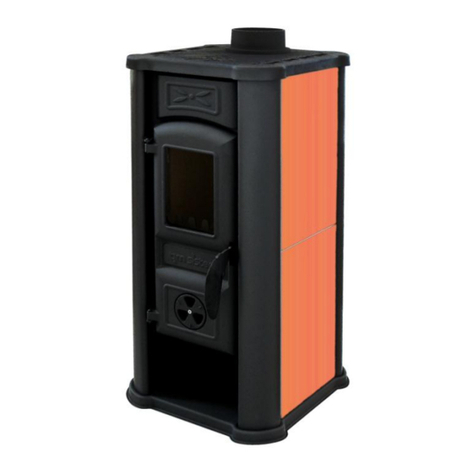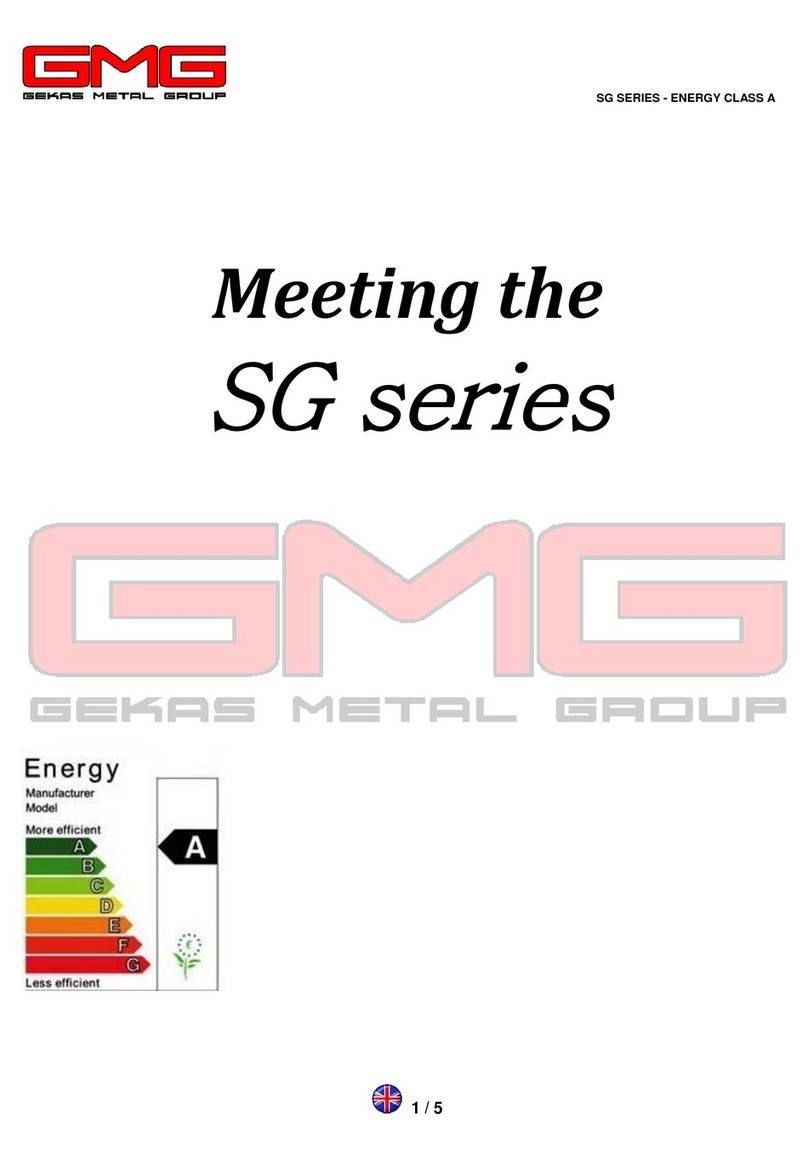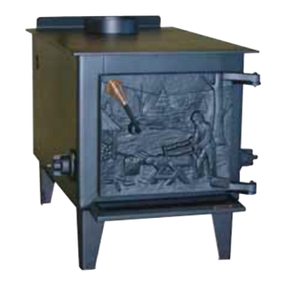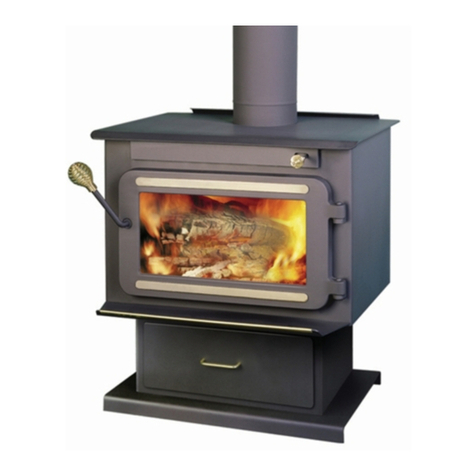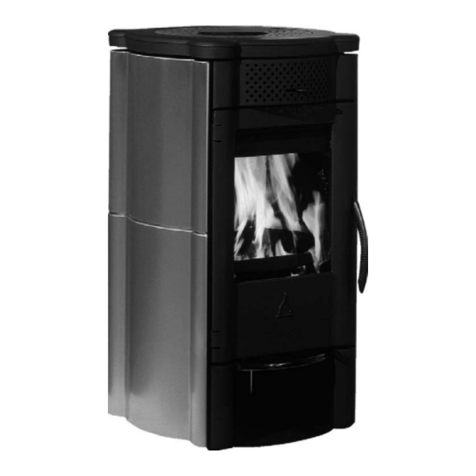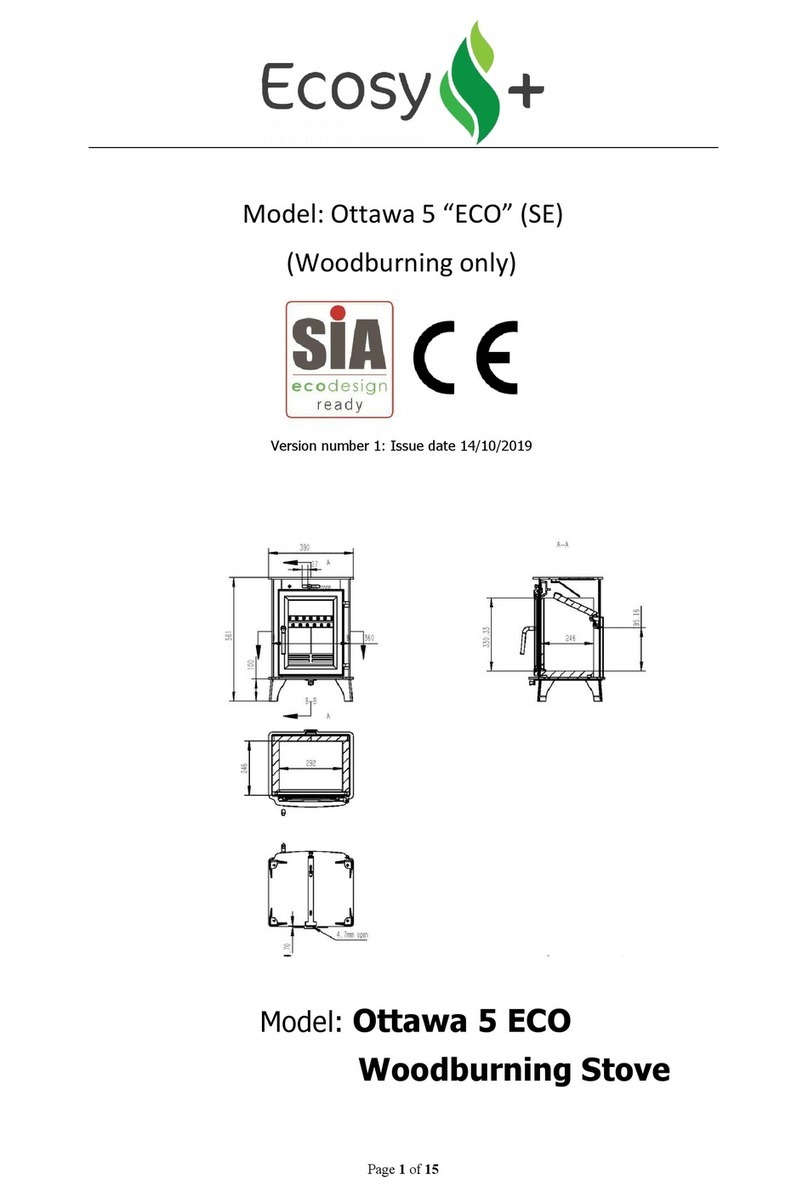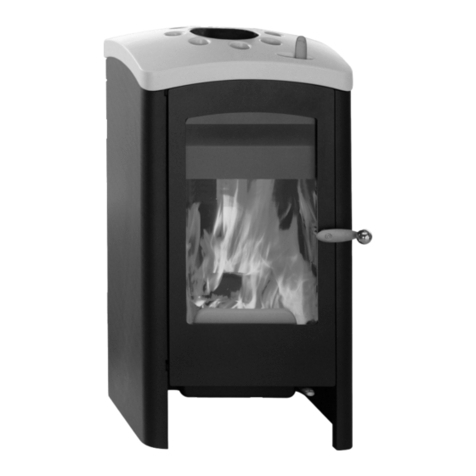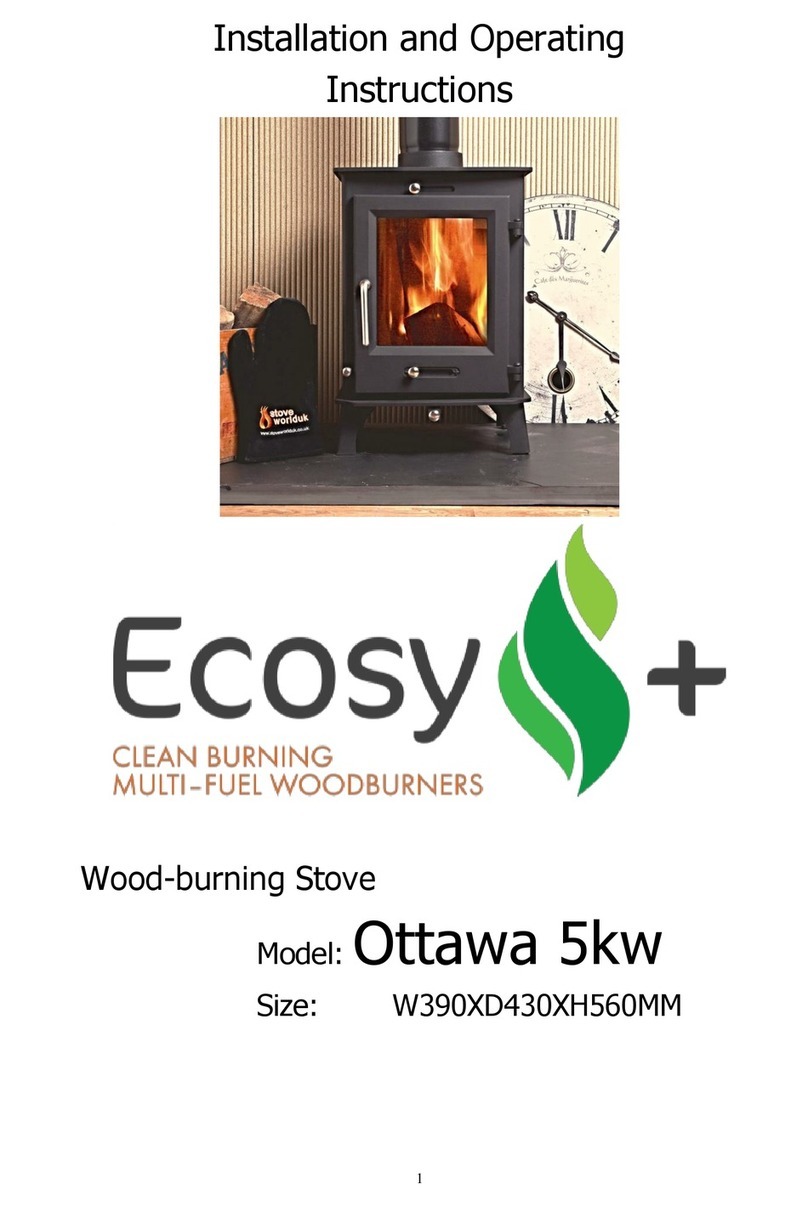Tim Sistem NORTH User manual

NORTH
Owners’s manual
INSTALATION, ADJUSTMENT AND OPERATING INSTRUCTION
EN 12815

Page 2
Dear Customer,
We appreciate your trust wested in us and decision touse "TIM SISTEM" product.
You have invested in energy-efficient and high-quality product - NORTH wood burning cooker.
Your purchase will provide you long-term clean and comfortable heating with minimal maintenance.
Please read these instructions carefully and completely.
It’s purpose is to inform you about the installation, operation and maintenance of your stove. Keep it handy
and refer to it as needed. You will find in it information that will be useful now and in the years to come.
Make sure that when installing the stowe all security standards have been respected and that all gas
pipes, connections between tubes and pipes and walls are connected properly.
Failure to comply with these standards and carelessness during installation can result in damage to
property or put your health and life in danger!
Set your cooker to a safe place, away from the frequent passages and doors, somewhere near chimney
and chimney connection.
We wish you manypleasant moments with NORTH.
TIM SISTEM d.o.o.
Safety: UL1482 ; ULC-S627
U.S. Environmental Protection Agency
This unit is not a certified wood heater. The primary use for this unit is for cooking and baking.
Tested by: GUARDIAN Fire Testing Laboratories, Inc
www.firetesting.com
Imported by: Sopka Inc
www.sopkainc.com

Page 3
WARNING BEFORE USE
To keep your cooker working properly, it is important to read this manual and strictly stick to the instructions
for use and handling.
For use with solid fuel only, such as wood and wood briquettes. It is forbidden putting explosive devices
and materials combustion chamber or the limited thermal furnace. It is forbidden to keep flammable
materials near the stove.
For proper combustion, in normal operating mode, draft in the chimney should be 10-12 Pa. If the draft is
greater than 15Pa, the valve should be installed in the chimney.
Room where the cooker is positioned must be vented regularly for the fresh air needed for combustion.
Some parts of cooker heat up during operation and it takes appropriate precaution when handling it. Do not
allow children to handle and play near the cooker.
Only spare partes reccomended and allowed by the manufacturershould be installed on the cooker. You
must not make any changes on the cooker.
With first firing there might show a mild smoke, especially from the plate’s surface. It is a common
appearance that occurs due to combustion deposits on the plate’s surface (corrosion protection, paint, dust
...). The room where the cooker is should be vented during the first firing.
It’s not reccomended connecting the cooker to the common chimney because it can adversely affect the
required draft.
Device that uses gas as fuel must notbe connected to same chimney.
During firing, use protection gloves because the door handles get heated.
National and local regulations for the installation of the furnace must be respected.
In a case of non-copliance with instructions given in this manual, manufacturer does not take any
kind of responsability for caused damage.

Page 4
DESCRIPTION OF THE COOKER
North Wood burning cooker is intended to be used for cooking and baking food and it's manufactured and tested
according European EN 12815 and UL1482, ULC-S627, American and Canadian standards.
The upper plate of the fireplace is made of steal.
Firebox doors are made of steal with fireproof glass.
Connection for smoke drainis being put on the plate and connected with screws.
All the materials that NORTH cooker is made can be recycled.
Sealing elements are made of materials that NOT contain asbestos.
Parts of the COOKER:
1. Protection rail 9. Wood drawer
2. Hotplate 10. Firebox door handle
3. Smoke exhaust 11. Primary air regulator
4. Flue gases register 12. Firebox door
5. Thermometer 13. Firebox
6. Oven 14. Secondary air regulator
7. Oven door
8. Oven door handle

Page 5
TECHNICAL DATA
Name NORTH
Use Solid fuel cooker
Nominal power Btu 31,500
efficiency % 84
Fuel Wood, wood briquets
Dimensions of the cooker W x L x H in 35.5x23.7x33.5
Dimensions of the fire place W x L x H in 11.5x17.7x11
Dimensions of the oven W x L x H in 13.8x18.7x11.6
Weight lbs 265
Minimum distance from flammable materials
Back in
6
Side in
6
Front in 36
Content CO (reduced on 13% O2) [%] % 0,091
Chimney connection in 6
Chimney connection position Left/right upper plate
Consuption by nominal power kg/h 1,5
Emission temperature °C 239
Air regulation Primary
Secondary
Required draft Pa/wc 12±2/ 0.040 – 0.057

Page 6
INSTALLING THE COOKER
Cooker must not be set up near the wooden parts, refrigeration parts, plastic furniture and other flammable
materials because during operation (during fuel combustion) it achieves high operating temperature that is
distributed on the outside of the furnace. Minimum distance between the stove and the
surrounding elements is 6”.
If the ground on which you set the cooker is made of easily flammable material (wood, warm floor, laminate
...) you need to set under the cooker a protetion sheet metal or any non flammable floor protector.
Because of its weight, the cooker must be installed on the appropriate base. If it does not satisfie necessary
standard, you must take appropriate measures to make it possible (eg, weight distribution).
Connect the cooker to achimney and flue pipes through the connector on top of the furnace, so as to
ensure adequate tightness and flow of smoke from the stove to the chimney. Flue pipe must not be drawn
too deeply into the chimney that would reduce the cross sectional area and thus undermined draft in the
chimney. Do not use reducers which reduce the cross section of pipe smoke.
The cooker requires insertion of fresh air in the room where it is installed, with surface openings for
insertion of fresh air should not be less than 0.4 dm ². The unit for fresh air set outside the common room
for ventilation, which must be insured by door and gride.
Fans that work in the same room where the cooker is installed may make interference wit the the cooker.
Also, all devices or ventilation that creates negative pressure in the room where the cooker is installed,
must be set in the way that does not make decompression that prevents normal operation of the furnace.
Before installing the cooker, check the chimney drafts because it is a key factor in the proper functioning of
the cooker. Draft depends on the proper opration of the chimney and meteorological conditions. One of the
easiest ways to check the draft in the chimney is with a candle flame, as shown in Figure 2 . Put a candle
near the chimney connection drain. If the flame bends towards drain, the draft is satisfying (Figure 2b). If
the flame doesn’t bend or bends a little, that indicates poor draft (Figure 2a).
If there is poor draft in the chimney (Figure 2a), check the chimney operation. The chimney should be
located inside the building, and if it’s located on the external walls of the building, it’s recommended
insulation chimney.
Figure 2a. Figure 2b.

Page 7
Disadvantages of the chimney (Figure 3): `
1. The chimney is higher than the top of the roof, a small cross section of the output,
2. Excessive slope
3. A sudden change of direction of the flue channel
4. Stove or some other device connected to the same flue channel,
5. Bulges in the flue channel
6. Cracks
7. Alien body or accumulated grime,
8. Tube inserted too deeply,
9. Fan or other device that creates a vacuum in the room
10.Unsealed or opened cleaning hole
Figure 3.

Page 8
IGNITION AND LIGHTING
Before the first firing, wipe all painted surfaces withclean and dry cloth, in order to avoid burning impurity on
the oven and creation of unpleasant smells.
Start the fire in the stoveby following order:
• open the fire door,
• place the fluel into the fire place (chopped wood to non greasy wrinkled paper)
• light a fire
• leave open primary air regulator until the flame gets stable and after
having stabilized the flame,control burning intensity with draftsregulator (Fig. 1, pos. 11)
• secondary air regulator leave opened until the flame gets stable and after
having stabilized the flame, control burning intensity with regulator (Fig. 1, poz.14)
• close the firebox door,
• after creating a basic flame insert larger pieces of wood or briquettesin the firebox, and
close the firebox door. If you use briquettes as a fuel, you must wait that all biquettes are lit and
then reduce the draft in half.
• when adding fuel, (Fig. 1, pos. 12) open the fire door step by step
wait for 4-5 seconds, and then slowly open it wide.
Do not open the doorsuddenly, when there’s a strong flame in the combustion chamber, it may come to it’s
spreaading into the room.
Regulating the draft in the cooker, you can regulate temperature, power and the combustion of fuel, and
this is done by running draft regulator on the firebox door (Fig. 1, pos. 11). Combining primary air through
the regulator onthe firebox door and secondary air over the leverage above the firebox door (Fig. 1, pos.
14) you get desired combustion.
Cooker contains auxiliary tools in order to facilitate its maintenance.
Recommended fuel: cord wood max length 16".
You must not use gasoline and similar fuels, because by using liquid fuels you crate conditions for
damaging the stove and to provoce an explosion.

Page 9
Attention!
• Do not use organic wasteas fuel, food residue, plastic, combustible or explosive materials, which
combustion disturbs the proper functioning of the cooker and may cause damage and environmental
pollution.
• Increased ambient temperature can cause poor air circulation (drafts) in the chimney, and in that case is
recommended more frequent firing in smaller quantities.
• Avoid using the cooker when there are bad weather conditions for the cooker andin the case of strong
wind, because it reflects the required vacuum in the chimney. In these cases there may occure potential
return of smoke in the room where the cooker is placed. Ignition is difficult then.
We recommend firing every hour with the amount of fuel in the combustion chamber up to 15cm with cross
stacking wood for better airflow.
After each refilling, it’s reccomender to leave the oven running in full speed for 30 minutes,in order to
destroy all volatile elements that may cause condesation in the cooker.
Correct cooker operation demands:
- Regular cleaning of the cooker and chimney
- Regular room ventilation for better combustion
- Regular ash tray cleaning
- Accumulated slag and unburned material regularly remove from the grid
WORKING REGIMES
There are four working regimes, which could be selected by adjusting the draught in the cooker.
Combined working regime - working regime in which it could be cooked in the oven, cooked on the top of
the hotplate and heat the room at the same time. It is necessary to push the flue gas register handle
towards the inside of the cooker, move primary air regulator to create medium inlet of the air.
Quick cooking - during this process it is the hotplate heats up intensively and to be able to do that with
small quantity of fuel, draw flue gas register handle completely outside, oven door should be shut and
move primary air regulator to create medium inlet of the air.
Heating for this regime it would be recommended to use wood or coal. If the coal is been used it would
require more frequent firing in order to create the ember which would intensively heat the hotplate of the
cooker. Push the flue gas register handle towards the inside of the cooker, move primary air regulator to
create medium inlet of the air and the oven’s door closed.
Baking for this regime push the flue gas register handle towards the inside of the cooker, move primary air
regulator to create medium inlet of the air and the oven’s door closed after putting the baking pan inside.

Page 10
HANDLING THE COOKER OPERATION
Start a fire with a moderate flame in order to avoid thermal shocks.
The following amounts of wood are inserted only after the previous volume burn.
Do not allow that ashes and unburned accumulate on the grid and to ta pit that way. Clean the grid.
Open the door slowly and carefully, allowing that way equalization of pressure in the firebox and in the
room, otherwise itmight cause the smoke in the room.
The cooker is designed and intended for use with firebox door constantly closed, except during refueling.
Do not open the door with no need.
The wood must be a maximum of 19% moisture content for maximum fire effect. Otherwise the tar gets
separated which with water steam may crate creosite. If that happens in some bigger quantitiy, it may lead
to a chimney fire. You will most easily recognize chimney fire by: the characteristic sound that comes out of
the chimney like loud roaring, visible flames coming out of the chimney, high ambient temperatures of
surrounding walls and the characteristic smell of burning.
If there comes to the fire do the following:
• Immediately call the fire squad
• muffle oxygen supply to the chimney and turn off the cooker
• Do not insert anything into the chimney and make sure that the fire does not spread to the wooden
construction or other combustible materials in its nearby.
• DO NOT pour water into the cooker or chimney
• A fire in the chimney can be extinct only with dry powder
• Water can extinguish only a surrounding material
• Do not cool the surrounding walls with water
Note:
If the fire in the cooker for some reason becomes dangerously strong take the following measures: close air
dampers that provide air for combustion. If it is necessary put in the firebox specially prepared sand for this
purpose or non-combustible fire blanket. It would be good to have a fire extinguisher.
Before the second charging, clean the gridin order to provide the fresh air.
Regularly clean the ash pan making sure that there is always a place for ashes.
The furnace is designed to operate in periodic mode. To maintain the required nominal power, combustion
chamber is periodically filled with prestabled amount of fuel.
Furnace is not designed to operate in continuous modeof heating or in accumulating temperature mode.

Page 11
CLEANING AND MAINTENANCE
Regular and proper cleaning allows proper operation and long life of the stove. All cleaning the interior or
exterior surfaces are always performed in a cold oven.
Cleaning exterior surfaces - is done with a soft cloth that will not damage the surface of the stove. Cleaners
of chemical origin can damage the surface of the fire place and cannot be used. Painted surfaces must not
be cleaned with abrasive products.
Cleaning inter surfaces –when cleaning use protective gloves.
Clean the bottom of the ovenfrom accumulated ash and pick up small unburned pieces of the grid, clean
the ashtray and ash accumulated in the interior of the fireplace.
Cleaning glass surfaces - glass on the firebox may get dirthy during the operation. For cleaning use a mild
detergent. Do not use abrasive cleaners because they can damage the surface of the glass. Clean the
glass only when cool.
Cleaning and maintenance of the chimney - chimney cleaning and control is recommended at least once a
year and after a long downtime. Regular maintenance and control of the chimney will prevent the
occurrence of fire and poor operation of stow.
Malfunction. Recommendations for its elimination
The following table shows the most common defects and recommendations for their removal.
Table: Showing the most common malfunctions, possible causes and ways of eliminating it.
Malfunction Possible cause Howe to remove it
Oven heats poorly
improper handling,
Poor uptake
Read carefully and follow the
instructions.
Inthe case that despite all
instructionshave been respected,
malfunctions are still not
removed, call the customer
service
Difficulties in lighting fire Closed regulator of air supply,
Wet wood,
Lack of oxygene
Open the regulator of air
supplyand provide a supply of a
primary air
Use a dry wood
Ventilate a room in order to
provide a supply of fresh air
Smoke reenters into a
room
Closed regulator of air supply,
Insufficient draft,
Remainings of ashes on a grid
Open the regulator of air
supplyand provide a supply of a
primary air
Read carefully the instructions
and apply advices how to provide
a draft
Clean the grid
Glass on a firebox door
are getting sooty for a
while
Wet wood
Too much fuel
Insufficient draft
Use a dry wood
Check a suggested quantity of a
fuel provided in a user’s manual

Page 12
Closed intake of secundary air Check a connection with a
chimney
Read carefully the instructions
and apply advices how to provide
secundary air
GENERAL RECOMMANDATION
If you have fullfield all the recommendations for installation, operation and control of cleaning, giveen in this
manual, the stove is now tested, safe device for household use.
Before installing the stove, remove the package. Be aware of potential injuries because the wooden slats
are connected with nails. Dispose a plastic bag in accordance with the regulations. Old stove you do not
want to use anymore, dispose to designated areas in accordance with the regulations.
All complaints, perceived failure or malfunctioning stoves, should be reported to the factory or authorized
service center by telephone or in written, only with fiscal receipt. All contact information provided at the end
of this guide.
Any malfunction of the cooker, must be removed by the manufacturer’s service only.
If unauthorized persons carry out any servicing or repairs and alterations to the stove, the owner loses the
right to the manufacturer's warranty.
Supply of spare parts has to be done viamanufacturer’sservice, based on the position and image of this
manual.
The manufacturer does not assume any responsibility if the buyer fails to comply with the instructions for
use and installation of the stove.
ADVICES FOR ENVIRONMENT PROTECTION
PACKAGING
Packaging material is 100% recyclable.
For a waste disposal of, act in accordance with local regulations.
Packaging material (plastic bags, polystyrene parts-polystyrene, etc.), should be kept away from children,
as a potential source of danger.
Take care of safe removing and disposing of wooden boards because they are connected with nails.
PRODUCT
The device is made of materials that can be recycled. When disposing the waste,act in accordance with
enviromental laws in effect.
Use only the recommended fuel.
It is forbiden burning an inorganic and organic materials (plastics, plywood,textile, oiled wood, etc..),
because the combustion releases carcinogenic materials and other toxics.

Page 13
SOLID FUEL COOKER “NORTH”

Page 14
List of all Positions on the "NORTH" cooker
1. Smoke exhaust
2. Hotplate carrier
3. Cookers frame
4. Flue gas register handle
5. Oven protector
6. Flue gas register
7. Rear inner panel
8. Rear exterior panel
9. Partition firebox panel
10.Rear carrier side panel
11.Inner side plate
12.Carrier side brick
13.Assembly oven
14.Deflector below the oven
15.Front carrier side panel
16.Oven grill
17.Side panel
18.Bottom of the oven
19.Corps carrier
20.Bottom plate
21.Mount drawer slide
22.Base assembly
23.Stationary slider
24.Moving slider
25.Decorative drawers mask
26.Wood drawer assembly
27.Wood drawer handle
28.Oven door
29.Oven door glass
30.Thermometer
31.Doors handle
32.Primary air regulator
33.Firebox door
34.Primary air box
35.Firebox door glass
36.Secondary air regulator
37.Decorative plate
38.Grill
39.Front plate assembly
40.Front plate protector
41.Side brick
42.Secondary air box
43.Side panel protector
44.Protection rail carrier
45.Protection rail
46.Hotplate
47.Back brick
48.Uper brick

Page 15
DIMENSIONS OF THE COOKER

Page 16
Owner’s Manual
DO NOT INSTALL IN MOBILE HOME OR TRAILER
Tested ttttoooo
UUUULLLL
1111482,
482,482,
482,
UUUUL
LLLC
CCC-
---S
SSS6
66627
2727
27
Solid Fuel Cook Stove
TTTTeeeesssste
tete
ted
ddd
to
to
to
to::::
EEEEN
NNN
11112
22281
8181
815
555
PLEASE READ ALL INSTRUCTIONS BEFORE YOU INSTALLYOUR NEW STOVE. FAILURE TO
FOLLOW INSTRUCTIONS MAY RESULT IN PROPERTY DAMAGE, BODILY INJURY, OR EVEN
DEATH.
SAFETY NOTICE: FOR YOUR SAFETY, CONTACT LOCAL BUILDING OR FIRE OFFICIAL
ABOUT PERMITS, RESTRICTIONS, AND INSTALLATION REQUIRE-MENTS FOR YOUR AREA.
PLEASE CHECK WITH YOUR INSURANCE BEFORE
USING IN YOUR HOME. USE PROFESSIONAL INSTALLER.
CAUTION
Hot while in operation- do not touch Contact may cause
skin burns
Keep children and clothing away
Keep furnishing and other combustible materials a considerable
distance away from stove.
Do not overfire. If stove or chimney connector glows, you are overfiring

Page 17
SAFETY INSTRUCTIONS
Read all instructions carefully.
1. The installation of this stove must comply with your local building codes. Please observe the clearance to
combustible. Stove must be 6"(15 cm) from any combustible material, wall, wood, furniture, paper, etc.
2. Always connect this stove to a chimney and vent outside. This stove requires approved masonry or factory
build 6" diameter UL 103 Type HT chimney, that is high enough to give good draft.
3. Do NOT connect this stove to a chimney flue serving another appliance.
4. Be sure that your chimney is safely constructed and in good repair. Have chimney inspected by the fire
department or a qualified inspector.
5. Creosote or soot may build up in the chimney connector and chimney and may cause a house or building
fire. Inspect the chimney connector and chimney twice monthly during the heating season and clean if
necessary.
6. Burning any kind of fuel uses oxygen from the dwelling. Provide fresh air for proper combustion from
outside the house into the room where the stove is located.
7. To prevent injury, do NOT allow anyone to use this stove who is unfamiliar with the correct operation of the
stove. Do not operate stove while under the influence of drugs or alcohol.
8. Flue connector pipe should be 6" diameter, minimum single wall 24 msg black or 25 msg blued steel.
(Listed to UL 103, Type HT and evaluated to CAN/ULC-S629-M87)
9. Do Not overfire. The special paint used on stove may give off some smoke and an odor while they are
curing during first few fires. Open windows and doors as needed to clear smoke and odor. Overfiring may
cause some damage to the stove.
10. Use only dry, seasoned, natural untreated wood. Do not burn garbage or flammable fluids, such as gasoline,
naphtha, kerosene or engine oil.
11. Use the metal ash drawer only to dispose of ashes. Dispose of ashes in a metal container with a tight fitting
lid. Keep the closed container on a non-combustible floor, well away from all combustible materials. Keep
ashes in the closed container until all cinders have thoroughly cooled. The ashes may be buried in the
ground or picked up by a refuse collec-tor.
12. CAUTION: Hot while in operation. All person, especially young children should be alerted and trained to
stay a safe distance from the stove. Small children should be all the time care-fully supervised when they
are in the same room with the stove.
13. This stove requires non-combustible floor protection.
14. Keep stove area clear and free from all combustible materials such as gasoline and/or other flammable
vapors and liquids at minimum 40".
15. Never leave an unattended woodstove burning on high.
16. It is highly recommended to install smoke and carbon monoxide detectors in the home when installing a
wood stove.
SAVE THESE INSTRUCTIONS

Page 18
INSTALLATION INSTRUCTION
1. Proper clearances must be maintained for adequate air circulation. Adequate ventilation must be provided while
operating this stove.
2. The stove must be placed on solid masonry, solid concrete, or when installing on combustible floor, on a UL
1618 listed floor protector or flammable floor must be protected by in-sulating plate ( steel, brass, marble, stone,
ceramic tiles, etc.) . The base must extend at least 18" (46 cm) beyond the front of the stove and 8"(20 cm) to the
sides, and MUST extend under the stove pipe. (Check local building codes and fire protection ordinances.) Floor
protector minimum size; 52“ x 50“ (131cm x 126cm)
3. The stove must have its own flue. DO NOT CONNECT THIS UNIT TO A CHIMNEY SERVING OTHER
APPLIANCES.
4. Connect flue collar to the stove and adapter for creosote leakage. The crimped end of the stove pipe must be in-
stalled facing down to fit inside the adapter. Figure 1, page 11
5. Use three (3) sheet metal screws at each joint of stove pipe and adapter to firmly hold stove pipe together. Use 6"
round black/blue stove pipe (Listed to UL 103, Type HT and evaluat-ed to CAN/ULC-S629-M87) NOT
galvanized pipe. DO NOT CONNECT THIS STOVE TO ANYAIR DISTRIBUTUIN OR DUCT SYSTEM.
6. Slope any horizontal single wall pipe and ceiling stove pipe upward toward the chimney at least 1/4 inch for each
foot of horizontal run.
7. You must have at least 18" of clearance between any horizontal pipe and ceiling.
8. The stove pipe must NOT extend to far into the chimney flue.
9. It is recommended that no more than two (2) 90 degree bends be used in the stove pipe installation.
10. Connect to 6" inspected masonry chimney or 6" UL Type HT listed chimney.
MASONRY CHIMNEY
Before using an existing masonry chimney, clean the chimney, inspect the flue liner and make any repair
needed to be sure it is safe to use.
If connector stove pipe must go through a combustible wall before entering the masonry chim-ney, consult a
qualified mason or chimney dealer. The installation must conform to local fire codes, and NFPA 211.
Do NOT connect this stove into the same chimney flue as the fireplace or flue from another stove. If there is a
cleanout opening in the base of the chimney, close it tightly.
UL LISTED CHIMNEY
Carefully follow chimney manufacturer's instructions. Us only a UL 103 Type HT Listed Resi-dential Type and
Building Heating Appliance Chimney. The top of the chimney must be at least three (3) feet above the roof and
be at least two (2) feet higher than any point of the roof within ten (10) feet.
NOTE: FLOOR EMBER PROTECTION IS REQUIRED FOR SPARK AND ASH SHIELDING, NOT
FOR LIMITING FLOOR TEMPERATURE FROM THE RADIANT HEAT OF THE APPLIANCE.
A PROFESSIONAL, LICENSED HEATHING AND COOLING CONTRACTOR SHOULD BE
CONSULTED IF YOU HAVE QUESTIONS REGARDING THE INSTALLATION OF THIS SOLID
FUEL BURNINGAPPLIANCE.

Page 19
Chimney connector systems and clearances
Chimney connector shall not pass through attic or roof space, closet or similar concealed space, or a floor, or ceiling. When
passage through a wall, or partition of combustible is desired, the installation shall con-form to CAN/CSA-B365, Installation
Code for Solid-Fuel-Burning Appliances and Equipment:

Page 20
CLEARANCES: Combustible
NON-combustible (Protected Walls)
Back of Stove 12" (30cm) 4" (10cm)
Side of Stove 12" (30cm) 4" (10cm)
Table of contents
Other Tim Sistem Wood Stove manuals
Popular Wood Stove manuals by other brands
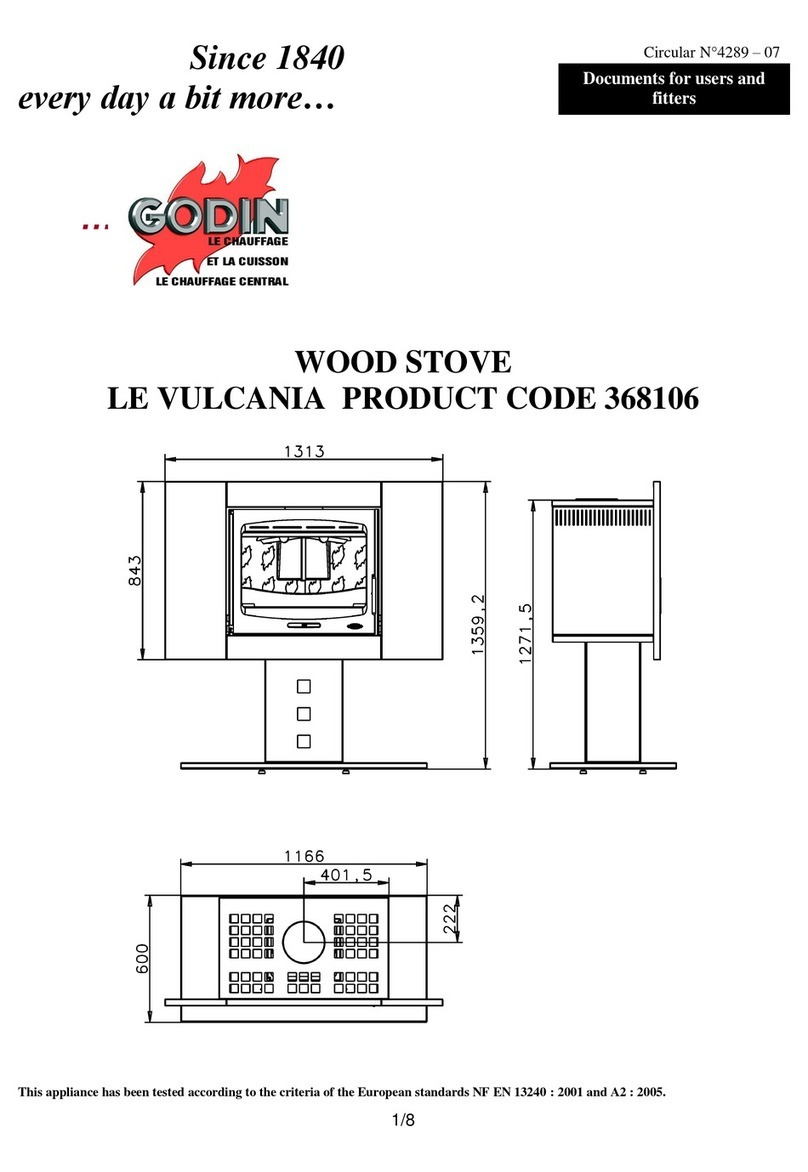
Godin
Godin Le Vulcania quick start guide

Blaze King
Blaze King PE1006 Operation & installation manual

deville
deville C077AP INSTALLATION AND UTILISATION MANUAL
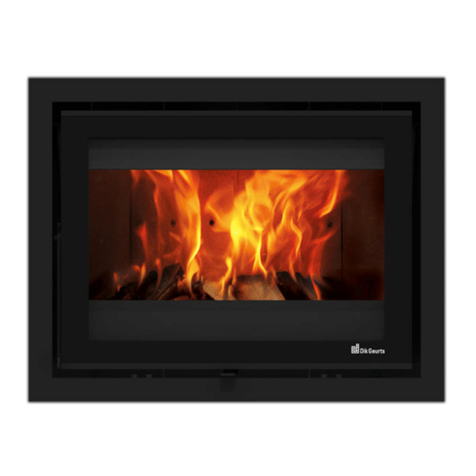
Dik Geurts
Dik Geurts Instyle 600V Next Instructions for installation
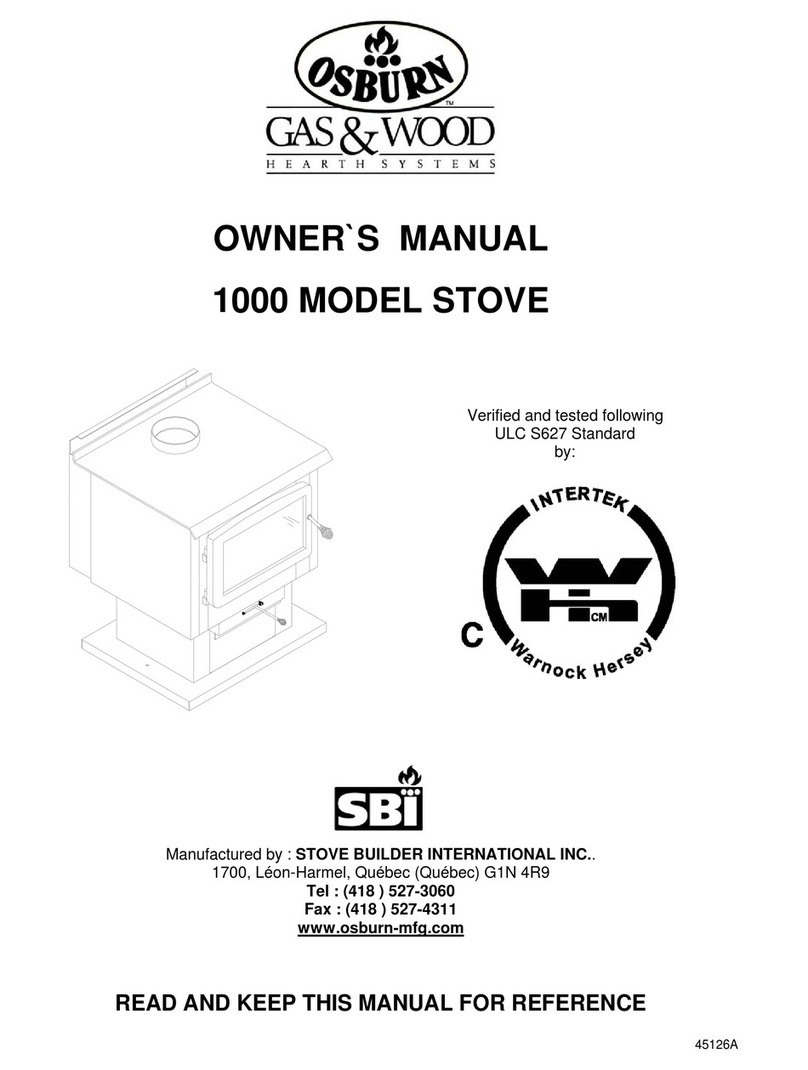
Stove Builder International
Stove Builder International OSBURN 1000 owner's manual
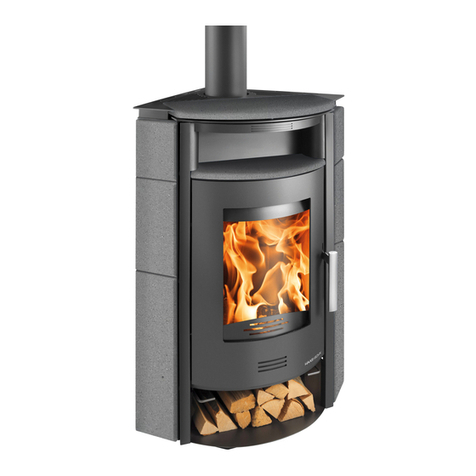
Haas+Sohn
Haas+Sohn Kuopio II Assembly instructions
